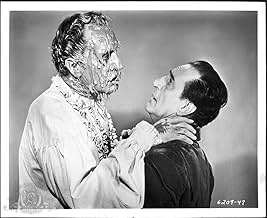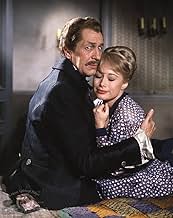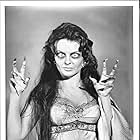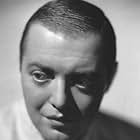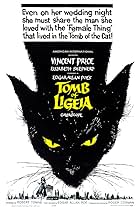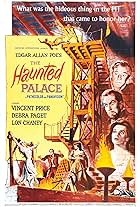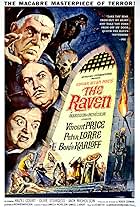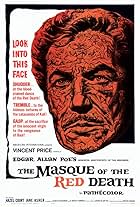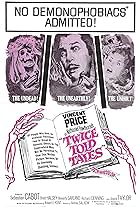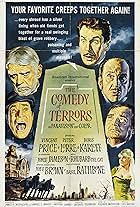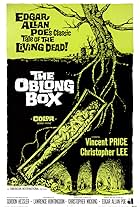IMDb RATING
6.8/10
8.6K
YOUR RATING
Three tales of terror involve a grieving widower and the daughter he abandoned; a drunkard and his wife's black cat; and a hypnotist who prolongs the moment of a man's death.Three tales of terror involve a grieving widower and the daughter he abandoned; a drunkard and his wife's black cat; and a hypnotist who prolongs the moment of a man's death.Three tales of terror involve a grieving widower and the daughter he abandoned; a drunkard and his wife's black cat; and a hypnotist who prolongs the moment of a man's death.
- Awards
- 2 nominations
Edmund Cobb
- Driver (segment "Morella")
- (as Ed Cobb)
- Director
- Writers
- All cast & crew
- Production, box office & more at IMDbPro
Storyline
Did you know
- TriviaThe "Black Cat" segment was recycled for "The Comedy of Terrors (1963)" (even the presence of a meddlesome cat). Many of the same actors appear in both films, only here Peter Lorre plays the drunk married to devoted Joyce Jameson, with Vincent Price introduced as the third member of the triangle; in "Comedy of Terrors" Price and Lorre exchange roles, and Jameson essentially repeats her performance. Not only that, but Price's line "What place is this?" from the "M. Valdemar" segment of "Tales of Terror" is recycled as a running gag for Basil Rathbone in "Comedy of Terrors".
- GoofsWhen Morella takes control of Lenora's body, as Vincent Price walks up the last time before the reveal, you can see a red backstage light in the "window."
- Quotes
Montresor Herringbone: Haven't I convinced you of my sincerity yet? I'm genuinely dedicated to your destruction.
- Alternate versionsThe shots of Valdemar 'liquefying' over Carmichael were originally cut from the UK cinema print and later restored for video.
- ConnectionsFeatured in Nightwatch Presents Edgar Allan Poe: Tales of Terror (1973)
Featured review
Roger Corman presents this horror anthology based on three stories by Edgar Allen Poe, where all three segments are introduced by and star Vincent Price.
Tales of Terror' is a movie which generally is hard to accept as a serious horror film, but fun when considered as a camp and kooky entry into the genre. Vincent Price is excellent in all three of his fairly contrasting roles and one could certainly see this film as a major piece of evidence when attempting to ascertain just how great and diverse a performer the late Mr. Price actually was. Roger Corman's directorial lavishness served to give the entire a movie a certain air of pomposity that lacked from some of his previous efforts and the varying directorial styles that Corman utilised throughout the film are the most prominent reason for the enjoyability of the movie.
In the first segment, entitled Morella', Vincent Price stars as Locke, a man traumatised to the point of insanity following the death of his wife (Leona Gage). Locke blames the early passing of his wife solely on his daughter Lenora (Maggie Pierce) and is therefore unimpressed and enraged when she shows up at his door twenty-six years since he last saw her. However, the relationship between the two starts to grow strong, before events take a horrifying turn. Easily the most solemn and horrific of the three stories, Morella' is unfortunately too short a segment for one to really enjoy the production. It seems that Corman preferred to concentrate the majority of the segment solely on the relationship between Lenora and her father, thus leaving the ending scenes looking rushed and the viewer to feel rather unsatisfied. That is not to say the story itself is not entertaining, it just does not appear to have fulfilled its potential. Good performances, some magnificent (albeit brief) haunting scenarios and a frightful image of a decomposed corpse are the highlights to this segment and certainly help to save it from the problems with pacing.
The following segment is far more corny and amusing. Entitled The Black Cat', this story follows the drunk, cat-hating Montressor (Peter Lorre) who during one of his less sober moments, challenges Vincent Price's wine-critic character of Fortunato to a wine-tasting contest and shortly Montressor begins to wish the two had never met. This segment seems so far removed from the opening segment that one could be forgiven for thinking they were watching a different movie. The Black Cat' takes a far more light-hearted tone as the entire segment is laced with camp humour particularly the facial expressions and general mannerisms of Vincent Price during the wine-tasting contest. This is a far more extravagant Vincent than we had previously seen. Despite one or two dramatic moments of tension and suspense, the segment never really sends any chills down the spine and is quite obviously present mainly for comedy value. It is in this story that Corman primarily chooses to utilise camera effects and visual trickery to set the mood, which is usually to enhance the humorous aspects of the film, such as during the wine-tasting contest where the effects are obviously used to show the increasing state of Montressor's intoxication. Even a hallucinatory sequence where Vincent Price's character plays with a severed head has an undeniable camp, comic charm. All in all, this segment is fun but far from truly horrifying.
The final segment, called The Facts in the Case of M. Valdemar', stars Vincent Price as a terminally ill man receiving pain relief through a form of hypnosis. Valdemar (Price) agrees to be hypnotised at the point of death by Carmichael (Basil Rathbone), much to the dismay and disgust of Valdemar's wife (Debra Paget) and physician Elliot James (David Frankham). Unlike the first segment, this one suffers by moving too slowly. Corman does an excellent job of building the tension where required, but he seems to take a rather lethargic approach to moving the story along. Performances from the entire cast were excellent and are the main positive aspect to the segment. Overall, this seems a fitting way to end the film and features one particularly gruesome scene. Just like the previous two segments, the story never really seems to fulfil its potential but can hardly be described as poor.
Generally, the film is entertaining despite the pacing problems and intermittent moments of overabundant camp humour. Horror fans should not go into this movie expecting a serious fright fest. Instead it is best to view when ready to see some great performances from Vincent Price in three rather differing types of story. Excluding a couple of scenes, one should not find anything horrifying about this film, but should find multiple amusing aspects and a jolly good time. My rating for Tales of Terror' 7/10.
Tales of Terror' is a movie which generally is hard to accept as a serious horror film, but fun when considered as a camp and kooky entry into the genre. Vincent Price is excellent in all three of his fairly contrasting roles and one could certainly see this film as a major piece of evidence when attempting to ascertain just how great and diverse a performer the late Mr. Price actually was. Roger Corman's directorial lavishness served to give the entire a movie a certain air of pomposity that lacked from some of his previous efforts and the varying directorial styles that Corman utilised throughout the film are the most prominent reason for the enjoyability of the movie.
In the first segment, entitled Morella', Vincent Price stars as Locke, a man traumatised to the point of insanity following the death of his wife (Leona Gage). Locke blames the early passing of his wife solely on his daughter Lenora (Maggie Pierce) and is therefore unimpressed and enraged when she shows up at his door twenty-six years since he last saw her. However, the relationship between the two starts to grow strong, before events take a horrifying turn. Easily the most solemn and horrific of the three stories, Morella' is unfortunately too short a segment for one to really enjoy the production. It seems that Corman preferred to concentrate the majority of the segment solely on the relationship between Lenora and her father, thus leaving the ending scenes looking rushed and the viewer to feel rather unsatisfied. That is not to say the story itself is not entertaining, it just does not appear to have fulfilled its potential. Good performances, some magnificent (albeit brief) haunting scenarios and a frightful image of a decomposed corpse are the highlights to this segment and certainly help to save it from the problems with pacing.
The following segment is far more corny and amusing. Entitled The Black Cat', this story follows the drunk, cat-hating Montressor (Peter Lorre) who during one of his less sober moments, challenges Vincent Price's wine-critic character of Fortunato to a wine-tasting contest and shortly Montressor begins to wish the two had never met. This segment seems so far removed from the opening segment that one could be forgiven for thinking they were watching a different movie. The Black Cat' takes a far more light-hearted tone as the entire segment is laced with camp humour particularly the facial expressions and general mannerisms of Vincent Price during the wine-tasting contest. This is a far more extravagant Vincent than we had previously seen. Despite one or two dramatic moments of tension and suspense, the segment never really sends any chills down the spine and is quite obviously present mainly for comedy value. It is in this story that Corman primarily chooses to utilise camera effects and visual trickery to set the mood, which is usually to enhance the humorous aspects of the film, such as during the wine-tasting contest where the effects are obviously used to show the increasing state of Montressor's intoxication. Even a hallucinatory sequence where Vincent Price's character plays with a severed head has an undeniable camp, comic charm. All in all, this segment is fun but far from truly horrifying.
The final segment, called The Facts in the Case of M. Valdemar', stars Vincent Price as a terminally ill man receiving pain relief through a form of hypnosis. Valdemar (Price) agrees to be hypnotised at the point of death by Carmichael (Basil Rathbone), much to the dismay and disgust of Valdemar's wife (Debra Paget) and physician Elliot James (David Frankham). Unlike the first segment, this one suffers by moving too slowly. Corman does an excellent job of building the tension where required, but he seems to take a rather lethargic approach to moving the story along. Performances from the entire cast were excellent and are the main positive aspect to the segment. Overall, this seems a fitting way to end the film and features one particularly gruesome scene. Just like the previous two segments, the story never really seems to fulfil its potential but can hardly be described as poor.
Generally, the film is entertaining despite the pacing problems and intermittent moments of overabundant camp humour. Horror fans should not go into this movie expecting a serious fright fest. Instead it is best to view when ready to see some great performances from Vincent Price in three rather differing types of story. Excluding a couple of scenes, one should not find anything horrifying about this film, but should find multiple amusing aspects and a jolly good time. My rating for Tales of Terror' 7/10.
- How long is Tales of Terror?Powered by Alexa
Details
- Release date
- Country of origin
- Language
- Also known as
- Edgar Allan Poe's Tales of Terror
- Filming locations
- Production company
- See more company credits at IMDbPro
Box office
- Gross US & Canada
- $3,270,000
- Runtime1 hour 29 minutes
- Sound mix
- Aspect ratio
- 2.35 : 1
Contribute to this page
Suggest an edit or add missing content



